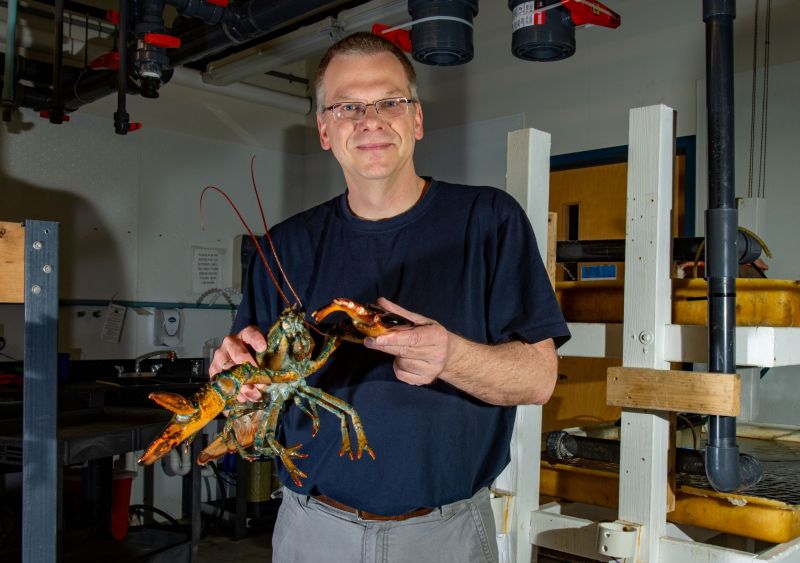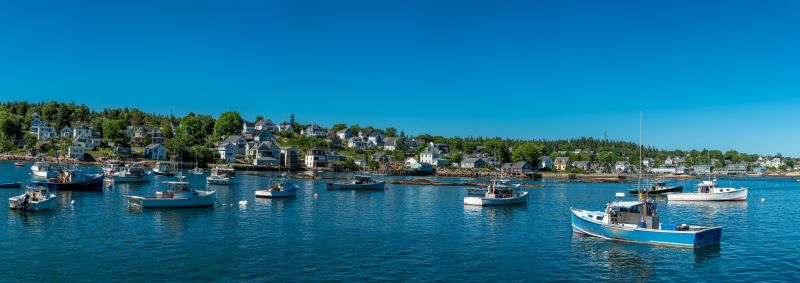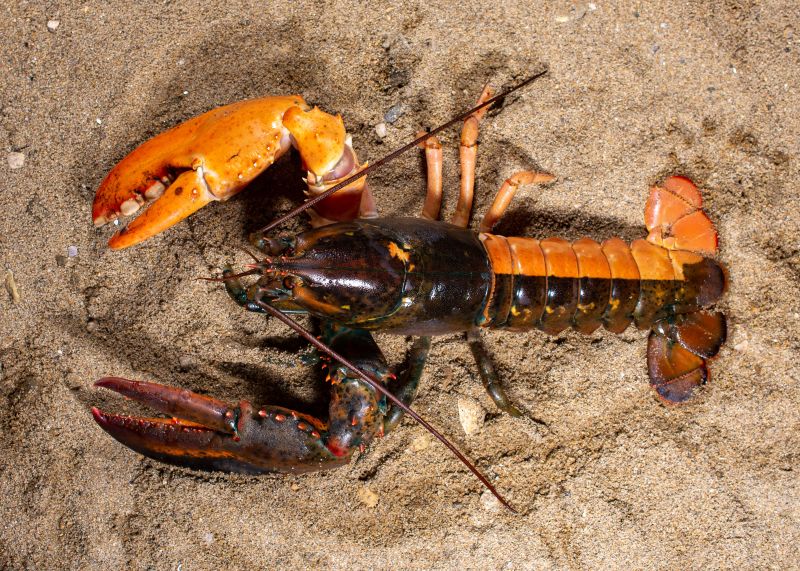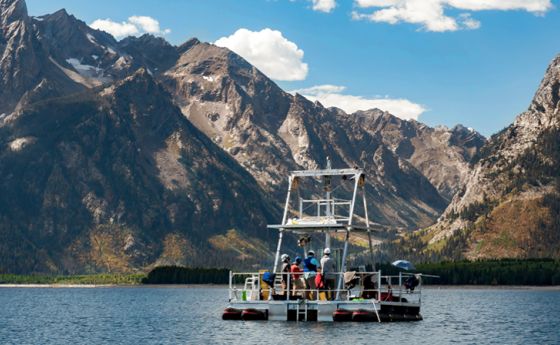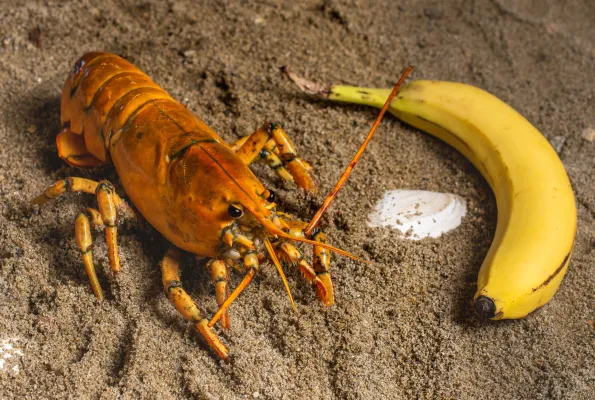
Golden lobster shines light on impact of climate change on ‘blue economy’
A colorful character has become the mascot for a research program studying the impact of climate change on the economically important lobster fisheries of Maine. "Banana," a bright yellow lobster, was caught off the coast of Maine and has found a home at the University of New England in Biddeford.
How did Banana get to be so bright? According to Markus Frederich, a marine scientist at the university, "The coloration of lobsters is caused by several pigment proteins, the main colors being yellow, blue and red. The mixture of these pigments, plus pigments that the lobsters take up through their food, gives the lobster the typical "lobster color." Most likely due to genetic mutations, some of the pigment proteins can be missing leading to a different coloration. In Banana’s case, the yellow color is dominant, overshadowing the blue and red.”
Roughly 1 in 30 million lobsters has the genetic mutation that causes the yellow shell color, and there are many different color varieties, including bright blue, calico (black and orange) and the rarest of all -- white lobsters. The people of Maine have seen them all, as the lobster population and the state are closely intertwined. This is why researchers are studying the impact of warming waters on the lobsters.
Concerns about climate change
Water temperatures near Maine have increased by 3 degrees Fahrenheit since 1900, and scientists found that between 2004 and 2013 water temperatures in the Gulf of Maine were warming seven times faster than the average global increase in ocean temperatures. This rapid increase resulted in higher mortality rates and fewer surviving offspring in cod stocks, and there are concerns there will be similar effects on the lobster population.
"Lobsters are cold water animals," Frederich said. "When the oceans get warmer, lobsters move into deeper, colder water, change the time when they molt, and become more susceptible for diseases. All this is happening already now in the Gulf of Maine. No other body of water is warming faster than the Gulf of Maine. In southern New England, the lobster fishery nearly collapsed because lobsters moved north and/or developed shell disease. This shell disease makes them less marketable." This could have dire consequences for Maine.
Lobsters’ critical relationship with Maine
Lobster fishing is a major component of the "blue economy" -- the various economic activities involving the oceans such as shipping, fishing, offshore energy production and marine tourism. In 2018, the blue economy was estimated to have supported 2.3 million jobs in the U.S. and contributed $373 billion to the nation's gross domestic product. Lobster fishing is the most valuable fishery in the country, worth an estimated $674 million in 2019.
"Lobsters are Maine’s most valuable marine resource," Frederich said. They account for 80% of the value of Maine’s sizeable -- and famous -- seafood industry. According to data from the Maine Department of Resources and an assessment by an economist from Colby College, annual catches of lobsters in the past few years were worth between $400 million and $500 million, contributed more than $1 billion to Maine’s economy through the supply chain, and generated more than 5,500 jobs. Even in 2020, during the pandemic, when trade with China (the largest importer of Maine lobsters) was severely limited, the lobster industry brought in more than $500 million.
Protecting lobsters and the people that depend upon them
Banana is not the only unusual lobster in the Frederich Crab Lab at the University of New England. There is a large lobster with an extra appendage on a claw that persisted through several molts, and there is a two-tone lobster, named Banana Split, that is actually conjoined twins -- one half is a normal lobster color, and the other side is a twin with one of the rare color mutations. The lab also has three larvae that are about six months old and have turned bright blue. "That we, by coincidence, caught three blue lobsters as larvae is unlikely, but we are still wondering whether this is genetic or nutritional. We certainly follow these blue baby lobsters closely," he said.
Anything that negatively impacts the lobster industry in Maine may have a significant effect on the state’s economy and the coastal communities. Frederich’s lab is sharing an $860,000 grant from the U.S. National Science Foundation with the Maine Department of Marine Resources, Bigelow Laboratory for Ocean Sciences and Hood College in Maryland to study the impacts that a warming Gulf of Maine is having on lobster larvae and their success growing to adulthood.
"Lobsters release their larvae into the water column. Floating near the surface, lobsters undergo several molts into different larvae stages and after about two months settle at the ocean floor as little baby lobsters," Frederich said. "How warming waters affect these larval stages is what our work addresses. We measure temperature tolerance, cellular stress markers and success in settling at the ocean floor at different depths and temperatures."
The work in the lab combined with existing data on adult lobsters is crucial to understanding how climate change and warming waters are impacting these cold-water dwellers and will result in a more accurate forecast of what will happen to lobsters and the connected fisheries. "The Gulf of Maine is currently warming faster than 99% of the earth’s oceans. Therefore, what happens here to the lobsters is a glimpse into the future of other oceans as well," Frederich said.
Banana is a particularly apt mascot for this project, considering how economically important lobster fisheries are for Maine and the blue economy of the U.S. in general. NSF support is critical to the work of Frederich and his colleagues. "Without the NSF, this multi-institutional project would not be possible. Our work includes specialists from several fields -- a lobster biologist, a physiologist, an ecologist and a modeler -- and logistical help from the Maine Department of Marine Resources. Only NSF supports this kind of work." In addition, NSF "allows us also to include undergraduate and graduate students to train them as the next generation of scientists."
By Chris Parsons, AAAS Science & Technology Policy Fellow, Division of Ocean Sciences, and Cory Hancock, Public Affairs Specialist

